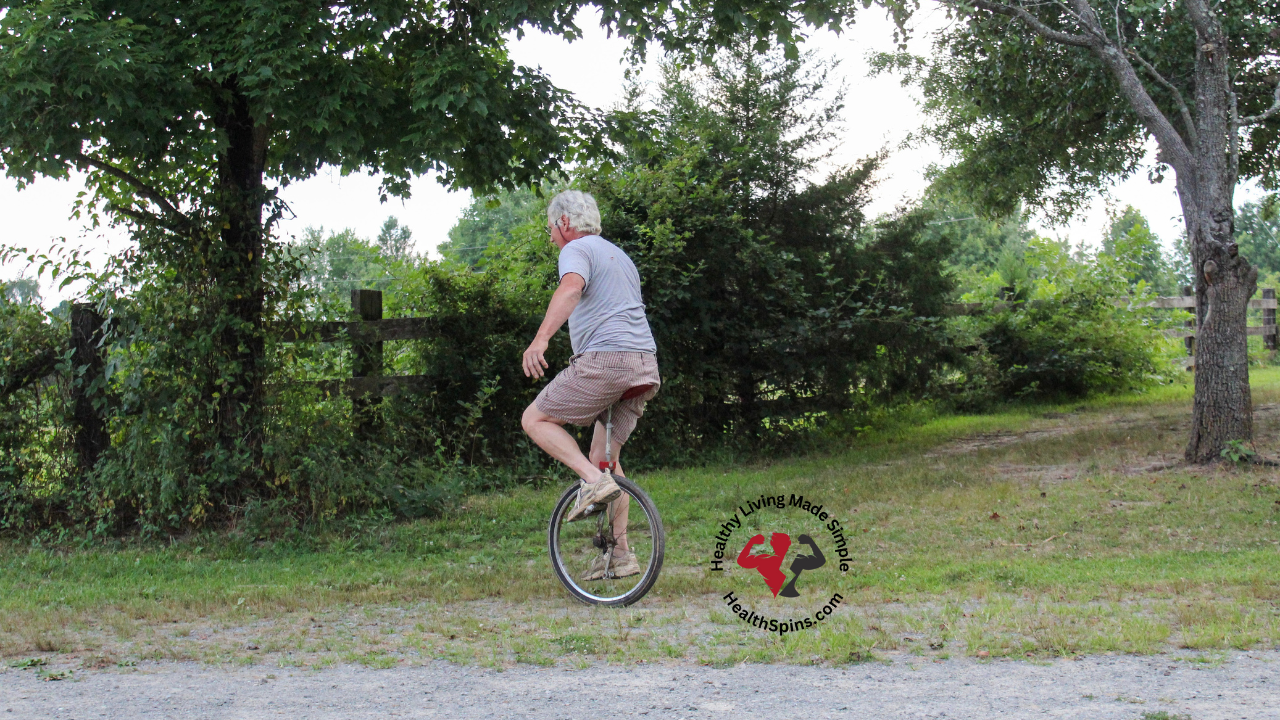We all want to stay independent and active as we age, and maintaining good balance is a must. It’s interesting that research indicates that balance can begin a decline as early as 50. Before we get into what I know to be the best balance exercise for seniors, let’s get a little background information.
Keeping your balance is an essential part of maintaining a high quality of life as we age. You see in this post why the decline, and what we can do to counteract it.
Why Balance Declines
There’s a complex interaction between your visual, musculoskeletal, and inner ear systems. to keep you balanced and upright. Each of those systems have to work together. They send signals to your brain about your body’s position and movements.
One of the problems with aging is that over time the systems can, and usually do, start to deteriorate. Here’s how it happens:
- Visual System: As you know, as we age our vision changes and gets worse. We begin losing our sense of depth perception and spatial awareness.
- Musculoskeletal System: Unless you’re really into regular exercise as you age, your muscle strength and flexibility declines. Now when we do momentarily lose our balance, our ability to react quickly and maintain an upright posture is compromised.
- Vestibular System: This is inside your ear and is responsible for detecting motion and orientation. That system also declines with age as it loses it’s sensitivity and leads to dizziness and problems with balance.
Impact of Declining Balance
When we’re younger, and our balance is in good working order, we recover from temporary losses of balances easily and many times in a day.
Now that we are seniors with declining balance, the risk of falls at what would have been a normal momentary loss of balance is increased significantly. And these falls are a leading cause of injury among older adults.
Falls that we used to get up and dust our selves off from, can now result in fractures, head injuries, and a loss of confidence. They also often enough lead to decreased mobility and then your independence.
Just the fear of falling causes some seniors to start limiting their activities. Now they are further reducing their physical fitness, and causing more balance issues.
Improving Balance
But, take heart, there’s good news. And that good news is that you can improve your balance
The good news is that there are many ways to improve balance and get the balance back that you lost from the effects of aging.
These are a list of some exercises that can strengthen the systems that support your balance. However, don’t forget, I’m going to show you the best balance exercise for seniors after this.
- Resistance Training: This is what you’ll find all over the internet as an example for seniors to enhance their balance. THIS IS A JOKE. Very few seniors, especially those with balance issues are up doing bridges, crunches, and planks. Palease?
- Yoga: Yoga poses will definitely help you with your balance and flexibility. Poses like the Tree Pose and Warrior III are excellent for improving stability and core strength. You can find books, both hardbacks and downloadable books on Amazon to help you with yoga at home.
- Tai Chi: Tai Chi improves coordination, balance, and overall body awareness. This is another option, but doesn’t help build muscle and strength that you need for the best balance.
Best Balance Exercise for Seniors at Home, or Most Anywhere
Resistance training, yoga poses, and tai ch are all excellent ways to improve your balance. Especially if you are not a senior citizen or already have enough strength and balance to practice those methods.
But, what if you don’t have enough balance, muscle, or strength to do those exercises? The tree pose is great, but it really takes a lot of practice for most people of any age. Same thing with the warrior pose. But what if your balance isn’t good enough to go there yet? That means that neither the resistance training, yoga, or Tia chi is really helpful for a lot of people.
Lucky for us, there are some simple techniques we can do if you’re struggling to stay balanced and don’t have a lot of strength. Here are a few examples:
- Heel-to-Toe Walk: Walk in a straight line, placing the heel of one foot directly in front of the toes of the other foot.
- One-Leg Stand: Stand on one leg for 30 seconds, then switch to the other leg. Hold onto a chair for support if needed.
- Balance on an Unstable Surface: Stand on a pillow or balance pad to challenge your stability.

If you think back to the beginning of this post, you’ll remember that there are three things that cause a decrease in balance with an increase in age. They were:
- Your vision: I can’t help there, other than going to the eye doctor.
- Your muscles: As we age, we lose muscle mass and tone, particularly in our legs, leaving us unable to recover from minor balance errors. You see, our balance is constantly having to make miro adjustments. Weak muscles simply make this task more difficult or impossible. When you experience a large balance problem, weak leg muscles have no way to recover.
- Your inner ear system: Your inner ear actually signals your brain each time a balance adjustment, no matter how minor, is required.
I’m going to tell you my best balance exercises that I use constantly for improving both balance and muscle strength in my legs. It’s simple as can be, and does both, and you need both to prevent falls. Falls for seniors can be devastating.
Standing on One Leg for Balance and Strength
Every chance I get I practice the one-leg-stand. If you’re able to stand, you can practice the one-leg-stand. If you do it every day, your balance and strength will improve more than your can imagine.
I find the best two places to practice is at the kitchen counter with your hands on the counter and standing at the back of any chair you can hold on to.

Practicing the one-leg-stand is so simple, but is really great for balance issues. Doing this exercise enhances your leg strength, your balance, and your stability.
The reason I prefer the kitchen for this exercise is the availability of surfaces to hold on to incase I lose my balance.
Core muscles are crucial for maintaining posture and quickly recovering from small and large loss of balance. Not only that, but you will improve your coordination and proprioception.
Get your confidence back when your practice standing on one leg for only minutes over and over each day.

Improve Your Balance When You Improve Your Vestibular System
Here’s the absolute best way for seniors to start improving their balance. And you won’t find this floating around the web, because it’s a paid method that is becoming extremely popular thorough the United States.
ENT clinics are setting up clinics everywhere for seniors to improve their balance. And here’s the core of what you’ll do when you or your insurance pays for your visits:
- Stand up as straight as you can, while holding a firm grip on a chair to keep from falling during the exercise.
- While standing, turn your head from side to side 10 time. Each time your face is looking at your left shoulder is one count.
- Still standing, and holding on to something for safety, looking straight ahead, look down to the floor. Now, look up to the ceiling. One full motion is from the floor to the ceiling. So, each time you look at the floor is one count. Do it 10 times.
- Now tilt your head so that it feels like you are attempting to touch your ear to your shoulder. Go from one shoulder to the other 10 times.
This is a very, very powerful method to restore your balance that has been lost in the Vestibular system. Clinics, which are sometimes referred to as dizzy clinics, will have you perform these exercises over and over for about 45 minutes 3 times a week.
The best way is to see all three variations as a set and do the set of 10 about 3 times either back to back, or waiting a few minutes between them. As your neck gets stronger and your balance improves while dizziness decreases, try doing each set 30 times.
Practice them with your eyes open, and then a complete set with your eyes closed.
I and my insurance definitely paid for this, and the results were extraordinary. I now practice this method daily to keep my balance in check.
Conclusion
Loss of balance leads to loss of independence. Improving and maintaining your balance is crucial for you as a senior. Your balance tends to deteriorate as you age leaving you with hyper increased risk of serious injuries.
We know that everyday activities like walking, climbing stairs or just moving from one chair to the other gets dangerous with loss of balance.
Fortunately, for us, though, you can improve your balance with exercises. The ones I’ve listed and explained are designed specifically to enhance your stability, strength, and coordination.
Not only will they help your prevent falls, they will boost your confidence to get up and get moving.
There’s another thing that falls under the heading of the best balance exercise for seniors. Moving! Walking is one of the best natural ways to improve and maintain your balance. So, go for walks and get regular exercise to keep your life as a senior active and independent.
